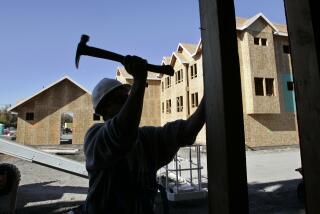Editorial: California finally acted on the housing crisis; will 2020 be even better?
California’s real estate and rental markets have long been expensive — even unaffordable — for many Californians. But the problem has spiraled out of control in recent years, and by 2019, it was overwhelmingly clear that what was once a garden variety housing shortage had been allowed to grow into a housing crisis.
Rents have risen faster than incomes, and 1 in 3 households statewide now spend more than half their income on rent, leaving many families one rent increase or one missed paycheck away from losing their homes. Despite massive infusions of public funding to try to solve the problem, counties across the state have reported double-digit increases in homelessness. The greatest job growth has been in coastal cities that have the highest housing costs, forcing workers to choose between paying more than they can afford for housing, commuting long distances or forgoing career opportunities because the cost of living is too high.
The consequences are apparent in the proliferation of tent cities, the growing number of mega-commuters who travel 90 miles or more (spewing greenhouse gases all the way) to get to work and the pessimistic polls that show residents are increasingly losing hope for the future in the Golden State.
Housing is at the root of the state’s problems. The good news is that California leaders took significant steps in 2019 to ease the problem. But California’s housing shortage is so steep and the affordability gap so wide, it will take more time and more ambition to end the crisis.
Gov. Gavin Newsom certainly had big ambitions for housing when he took office in January. On the campaign trail, Newsom said he wanted the state to build 3.5 million homes by 2025 to end the housing shortage. In his first weeks on the job, the governor called for a “Marshall Plan” for affordable housing, and he made headlines with a threat to withhold transportation dollars from communities that failed to build enough homes to meet their needs.
In the end, Newsom did deliver a big increase in funding this year — nearly $3 billion for housing and homelessness. But to appease legislators and angry city officials, he watered down his proposal to withhold transportation dollars. Instead he agreed to a compromise bill that would allow a judge to impose steep fines — up to $600,000 a month — on cities that willfully refuse to plan and zone for enough market-rate and affordable housing.
Newsom stayed on the sidelines during the debate over Senate Bill 50, the controversial measure that would have overridden local zoning laws to allow mid-rise apartment buildings to be constructed within half a mile of major transit stops or in “jobs-rich” areas, even in single-family neighborhoods. The bill was shelved and will be reintroduced in January. And Newsom didn’t make much progress on a grand bargain to reform the California Environmental Quality Act so that it can no longer be used to block much-needed housing.
There has been some grumbling that Newsom’s results don’t match his rhetoric. That’s true. The governor does have a penchant for overpromising. But we prefer to cut him some slack on this one because it’s unrealistic to think a governor can reverse decades of political and NIMBY intransigence on housing in one year. And the fact is, California did make real progress.
Newsom and lawmakers enacted a slew of laws to encourage new housing. It’ll be easier to build granny flats in the future. Permitting and approval for new homes have been streamlined.
Legislators passed a bill to establish the nation’s strongest statewide rent control law. As of Jan. 1, most annual rent increases will be capped at 5% plus inflation, and landlords will have to show “just cause” before they evict a renter. The law, which sunsets after 10 years, is a common-sense measure that provides some stability for renters, who have borne the brunt of the state’s housing crisis.
The politics on housing are shifting. Even though renters make up nearly half the state’s population, tenant protection bills have a history of failing in Sacramento, thanks to powerful landlord and real estate interests.
Likewise, California officials have long believed that cities and counties should have almost complete control over housing decisions. In practice, however, local control often means saying “no” to new development. Most cities in California have shied away from denser, compact development that would be more walkable, bikeable and transit-friendly.
That is changing too. Under pressure from Newsom and housing advocates, Southern California leaders reluctantly agreed to plan for the development of more than 1 million new homes in the region by 2029 — with much of the housing concentrated in the coastal areas. These are communities that have jobs, transit and amenities but tend to oppose new development, and the commitment to focus growth in those areas will help combat urban sprawl.
There’s also a shift on single-family zoning, which has long been held sacrosanct in California. Apartments and condos are banned in nearly 80% of the state’s residential neighborhoods. Closing those areas off to multi-family development dramatically limits the number of homes that can be built. Often, it means that would-be-residents cannot live near good schools or their jobs, and it perpetuates racial and economic segregation.
That’s why Oregon and Minneapolis have done away with single-family zoning. SB 50 would have done so as well, by allowing property owners to convert houses anywhere in the state into four-unit apartment houses, and that proposal will be back for consideration in January. The mayors of Los Angeles, Oakland, San Jose and Sacramento have all expressed interest in allowing small apartment buildings in single-family neighborhoods.
There’s still so much work ahead. California has to make it much easier and cheaper to build housing. The state and local governments need to figure out ways to incentivize — or subsidize — the development of a lot more low- and middle-income housing. The coming year will be a test of whether California can truly turn into a pro-housing state.
More to Read
A cure for the common opinion
Get thought-provoking perspectives with our weekly newsletter.
You may occasionally receive promotional content from the Los Angeles Times.










